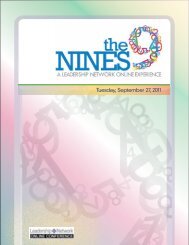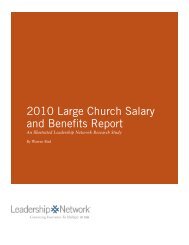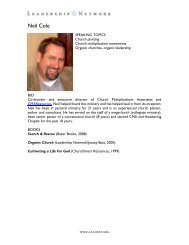ARE WE A PEOPLE AT HALF TIME? - Leadership Network
ARE WE A PEOPLE AT HALF TIME? - Leadership Network
ARE WE A PEOPLE AT HALF TIME? - Leadership Network
Create successful ePaper yourself
Turn your PDF publications into a flip-book with our unique Google optimized e-Paper software.
sage one day. “We form local congregations<br />
as if they were clubs. And then we<br />
behave as if they were clubs. But clubs are<br />
anti-growth.” Tully added, “Working to<br />
keep a church at a comfortable number is<br />
almost always self-defeating. Organically,<br />
that’s stasis, and it spells death eventually.<br />
A church that consciously grows will learn<br />
to ask of everything that it pursues, Does<br />
this help us grow Or, does this keep us the<br />
way we are”<br />
It is not accidental that the latest generation<br />
of large churches, with their huge<br />
auditoriums and balconied atriums, some<br />
with food courts and fountains, resemble<br />
secular gathering places. (Banks and colleges<br />
used to build their buildings to look<br />
like Gothic cathedrals.) By adopting nonthreatening<br />
architecture, the large churches<br />
are finding another way to lower psychological<br />
barriers against the church edifice.<br />
The multi-use church facilities open their<br />
doors to every kind of community group<br />
for meetings.<br />
Experience has taught these churches<br />
that after the initial exposure, size can soon<br />
alienate the potential new member. The<br />
small-group system that Willow Creek<br />
gave its own expression to, which has itself<br />
been widely adopted by even not-so-mega<br />
churches, encourages every new member<br />
to join a cell of usually no more than ten<br />
people, led by a lay person. Such a cell,<br />
says Willow Creek’s small-groups czar,<br />
Jim Mellado, “is the basic unit of church<br />
life.”<br />
The perfume of these groups may be<br />
Christian, but their integument is social.<br />
Ideally if not always practically, your cellmates<br />
are the ones who are there for you<br />
when your parent dies, or when you’re lugging<br />
your stuff to a new apartment, or<br />
when you have to go to the doctor all of a<br />
sudden and you need someone to pick up<br />
the kids after school. Relationships, that is.<br />
Neighbors. Family, when so many people<br />
seem not to have a family anymore. What<br />
used to happen naturally, at least in the<br />
small-town America we mythologize,<br />
today needs a little more deliberateness.<br />
“We have to work at keeping the village,”<br />
a small-group enthusiast at a church in<br />
Minneapolis told me.<br />
A THIRD FORCE<br />
What may at first go unremarked when<br />
one beholds all the small-grouping and<br />
service being provided for people who<br />
come to these<br />
churches is the<br />
service being<br />
provided by all<br />
those people<br />
who are already<br />
there. Teaching<br />
Sunday school<br />
and arranging<br />
flowers and passing<br />
the plate<br />
have long been<br />
the formal obligations<br />
of any<br />
Protestant congregation’s<br />
core.<br />
But the degree<br />
and intensity of<br />
participation in<br />
the Next Church<br />
is on a wholly<br />
different scale.<br />
The churches,<br />
even the ones<br />
with enormous<br />
paid staffs can<br />
truly be said to<br />
be led and staffed by their laity.<br />
The overwhelming reality is that the<br />
bulk of the people who make the church<br />
function are volunteers. One of the basic<br />
elements of large-church management is<br />
identifying the “gifts” of people in order to<br />
fit them to the church’s various ministries.<br />
What brings people to their gift of service<br />
is a desire to do something that—perhaps<br />
unlike their day job, perhaps unlike their<br />
evenings—matters. Among the things that<br />
they didn’t realize they wanted when they<br />
came back to church, in the view of many<br />
people I met, was not just a changed life<br />
but the chance to change the lives of others.<br />
Peter Drucker has written approvingly<br />
of what he calls the pastoral churches as<br />
yeasty new sources of nonprofit-sector<br />
volunteerism. In the view of Drucker, these<br />
churches are an integral part of a potent<br />
and largely unseen “third force” of volunteer<br />
productivity and philanthropy that is<br />
picking up what the private sector has forsaken<br />
and the public sector has squandered.<br />
Drucker says that<br />
Americans today go to church<br />
for reasons very different<br />
from those of two generations<br />
ago. Then attendance was<br />
steered by heritage, habit, and<br />
social status. “Now,” he told<br />
me recently, “it is an act of<br />
commitment, and therefore<br />
meaningful. It is no longer an<br />
act of conformity, and therefore<br />
meaningless. People<br />
need community, yes, and<br />
they need a spiritual identity,<br />
yes, but they also need<br />
responsibility. They need the<br />
feeling that they contribute.”<br />
GO FORTH AND MULTIPLY<br />
Willow Creek Community<br />
Church, the Fellowship of Las<br />
Colinas, Saddleback Valley<br />
Community Church, Mariners<br />
Church, Wooddale Church,<br />
Calvary Chapel, the Church<br />
of the Open Door, the<br />
Community of Joy, House of<br />
Hope, Gateway Cathedral, New Life<br />
Fellowship... these places have something<br />
in common: they whisper no word of a<br />
denomination.<br />
In some cases that’s because the church<br />
belongs to none. The Next Church is sui<br />
generis, a house built of local materials and<br />
independent pluck and zeal. In other cases<br />
the church would just as soon not mention<br />
that it owes allegiance to any remote earthly<br />
institution. In a few cases the church<br />
doesn’t even call itself a church.<br />
Though many congregations in the<br />
Next Church retain nominal membership<br />
in mainline or evangelical denominations,<br />
and some are thriving as parts of a greater<br />
ecclesiastical whole, what they are concealing<br />
in the names they have chosen is at<br />
the heart of the great convulsion going on<br />
in American church life: the challenge to<br />
5







